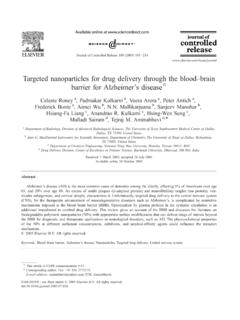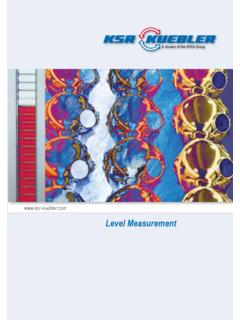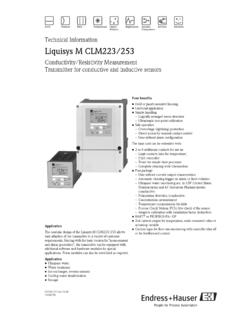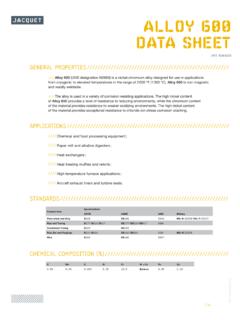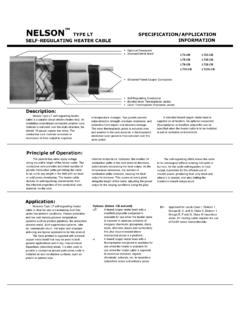Transcription of Polyaniline Nanofiber Synthesis by Co-Use of …
1 Polyaniline Nanofiber Synthesis by Co-Use of AmmoniumPeroxydisulfate and Sodium HypochloriteAbdelaziz Rahy, Mohamed Sakrout, Sanjeev Manohar, Sung June Cho, John Ferraris, and D. J. Yang*, Department of Chemistry & the Alan G. MacDiarmid NanoTech Institute, The UniVersity of Texas atDallas, Richardson, Texas 75080, Center for Green Chemistry, Department of Chemical Engineering,UniVersity of Massachusetts Lowell, Lowell, Massachusetts 01854, and Department of Applied ChemicalEngineering, Chonnam National UniVersity, Kwang-Ju, KoreaReceiVed December 24, 2007.
2 ReVised Manuscript ReceiVed January 30, 2008 The polymerization to Polyaniline nanofibers was carried out in an aqueous system using aniline, 1 MHCl. and ammonium peroxydisulfate (APS) with additional use of sodium hypochlorite solution as aco-oxidant. The addition of sodium hypochlorite solution was made either before or after the addition ofAPS. This new method always produces Polyaniline nanofibers with long length. Additional advantagesof this new method are discussed. The effect of aniline concentration, hypochlorite concentration, differentacid use, reaction temperature, and both aniline and hypochlorite purity on morphology and electricalproperty of the nanofibers synthesized by this new method was IntroductionConductive polymers, such as polyacetylene and poly-aniline, have been the subject of numerous investigations inthe past two the electrically conductingpolymers, Polyaniline (Pani)
3 Has attracted intense attentiondue to its environmental stability, ease of Synthesis , excitingelectrochemical, optical, and electrical ,3 Nanofi-bers of Polyaniline have attracted even more interest becauseof their properties that make them possibly suitable forapplications as sensors,4 6batteries,7,8molecular electronicdevices, corrosion inhibitors9,10and separation ,12 Polyaniline may be synthesized by either electrochemical orchemical oxidative techniques13and can be doped to a highlyconducting state by protonic acids. In recent years, consider-able efforts have been made to find specific synthesisconditions and methods for the Synthesis of polyanilinenanofibers.
4 There are several reports by the use of hardtemplates,14soft templates,15seeding,16interfacial poly-merization,17and , David et nanofibers of semiconducting and metallicpolyaniline nanofibers. Li et the Synthesis ofpolyaniline nanofibers by conducting the conventional po-lymerization reaction at an elevated temperature withoutmechanical agitation, and Jing et al. synthesized polyanilinenanofibers by dropwise addition of a solution of ammoniumperoxydisulfate (APS, (NH4)2S2O8) into an aqueous anilinesolution in the presence of the ultrasonic described above, Synthesis of Polyaniline nanofibersrequires specific conditions.
5 We report here that our new* Corresponding author. Tel.: 1 972 883 6681. Fax: 1 972 883 2925. The University of Texas at Dallas. University of Massachusetts Lowell. Chonnam National University.(1) Chandrasekhar, Polymers, Fundamentals and Applica-tions: A Practical Approach; Kluwer Academic Publishers: Boston, (2) (a) MacDiarmid, A. Chem. Int. ,40, 2581. (b)MacDiarmid, A. ,84, 27.(3) MacDiarmid, A. G. Chiang, J. C. Richter, A. F. Somasiri, N. L. , A. J.; Alacer, L., Polymers; D. ReidelPublications: Dordrecht, The Netherlands, 1987; pp 105 120.
6 (4) Janata, J.; Josowicz, ,2, 19.(5) Huang, J. X.; Virji, S.; Weiller, B. H.; Kaner, R. Am. ,125, 314 315.(6) Virji, S.; Fowler, J. D.; Baker, C. O.; Huang, J.; Kaner, R. B.; Weiller,B. ,1(N 6), 624 627.(7) MacDiarmid, A. G.; Somasiri, N. L. D.; Mu, S. L.; Wu, W. Q.; Chiang,J. C.; Huang, W. S.; Halpern, M. Electrochem. ,131,C328.(8) MacDiarmid, A. G.; Yang, L. S.; Huang, W. S.; Humphery, B. Met.,1987,18, 393.(9) Deberry, D. Electrochem. ,132, 1022.(10) Mengoli, G.; Musiani, M. M.; Pelli, B.; Vecchi, Appl.
7 ,28, 1125.(11) Anderson, M. R.; Mattes, B. R.; Reiss, H.; Kaner, R. ,252, 1412.(12) Kaner, R. ,125, 65.(13) Huang, W. S.; Humphrey, B. D.; G MacDiarmid, Chem. Soc.,Faraday ,82, 2385.(14) (a) Martin, C. Chem. ,28, 61. (b) Martin, C. ,8, 1739.(15) Qiu, H.; Wan, M.; Matthews, B.; Dai, ,34,675.(16) (a) Zhang, X.; Goux, W. J.; Manohar, S. Am. Chem. ,126, 4502 4503. (b) Xing, S.; Zhao, C.; Jing, S.; Wang, ,47, 2305 2313.(17) (a) Huang, J.; Kaner, R. Chem., Int. ,43, 5817 5821. (b) Huang, J.; Kaner, R. Am. Chem.
8 ,126, 851.(c) Huang, J.; Virji, S.; Weiller, B. H.; Kaner, R. Am. ,125, 314. (d) Zhang, X.; King, R. C. Y.; Jose, A.; Manohar,S. ,145, 23 29.(18) (a) Pinto, N. J.; T Johnson, A., Jr.; MacDiarmid, A. G.; Mueller, C. H.;Theofylaktos, N.; Robinson, D. C.; Miranda, F. Phys. ,83, 4244. (b) Zhou, Y.; Freitag, M.; Hone, J.; Staii, C.; Johnson,A. T., Jr.; Pinto, N. J.; MacDiarmid, A. Phys. ,83,3800.(19) Sarno, D. M.; Manohar, S. K.; MacDiarmid, A. ,148, 237 243.(20) Chiou, N. R.; Epstein, A. Met.,2005,153, 69 72.(21) Li, D.; Kaner, R.
9 Am. Chem. ,128, 968 975.(22) Jing, X.; Wang, Y.; Wu, D.; Qiang, ,14, 75 ,20,4808 CCC: $ 2008 American Chemical SocietyPublished on Web 07/17/2008robust method, comprising the addition of sodium hypochlo-rite before of after APS addition, always produces nanofibersat wide ranges of aniline concentrations and that of temper-ature (0 30 C). Polyaniline nanofibers produced by this newmethod are several micrometers in length with less than 40nm diameter with narrower molecular weight distributionscompared to the Synthesis done with APS Experimental (Aldrich, ACROS) was either used asreceived or distilled and stored in a refrigerator prior to peroxydisulfate (APS, ACROS), sodium hypochlorite14% (VWR)
10 , and hydrochloric acid were used without Synthesis of Polyaniline a typical Synthesis , mL of aniline was dissolved in 100 mL of 1 M hydrochloricacid while g of ammonium peroxydisulfate (APS) was dissolvedin 100 mL of 1 M hydrochloric acid. Twenty milliliters of APSsolution was added quickly to the aniline mixture and mixed. Thisgives aniline to APS molar ratio of 1 The reaction vessel wasmaintained either at ice bath temperature (0 to 5 C) or roomtemperature. Once the reaction starts, 2 mL of an aqueous sodiumhypochlorite (5% by wt) solution was quickly added dropwise withagitation after which the stirring was stopped.
